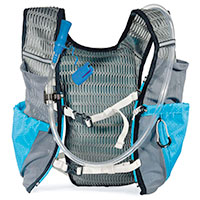Running is the exercise of choice for many individuals, who see it as an expense-free way of maintaining their cardiovascular fitness and in many cases, body weight. Runners may enter races over distances from 5 kilometres up to marathons or may run simply for their own enjoyment and health benefits.
Common Running Injuries
Most running injuries are classed as overuse injuries which tend to build up over a period of time. This is due to the repetitive nature of the sport.

Running Hydration Packs
Plantar fasciitis
Plantar fasciitis is probably the most common cause of heel pain. It is often worse first thing in the morning. Treatment involves cold therapy to reduce pain and inflammation, orthotic inserts and Plantar fasciitis exercises.
Patellofemoral pain
Patellofemoral pain is a bit of an umbrella term, used to describe pain in the front of the knee joint which comes on for no apparent reason. It can have many causes and usually, a case will have a combination of factors, rather than one main cause.
In the case of runners, the most common causes are weak hip abductors, tight lateral structures of the knee, weak VMO (teardrop muscle above and to the inside of the knee cap) and overpronation. Treatment for patellofemoral pain usually incorporates an exercise program to stretch and strengthen affected muscles. Learn more about patellofemoral knee pain.

Technical Running Socks
Iliotibial band syndrome
ITB syndrome, also known as runner’s knee, is irritation of the insertional portion of the band, where it crosses the outer knee joint and attaches to the Tibia (shin bone). Causes of ITB syndrome include weak hip abductors, a tight IT band, overpronation and lots of hill running. Treatment of ITB syndrome involves treating the causative factors as well as the symptoms of pain at the outside of the knee joint. Find out more about ITB syndrome.
Shin splints
Shin splint is a term often used to cover all pain at the front of the lower leg. This is not the case. True shin splints (now often known as medial tibial stress syndrome), are pain which occurs on the inner side of the shin bone. Symptoms may disappear with rest, only to reappear with activity, there may be pain when raising the toes and the area may be tender to touch and feel ‘bumpy’. Shin splints have many causes, including foot overpronation, oversupination, calf muscle tightness, inadequate footwear and overtraining. Learn more about shin splints.
Plantar fasciitis
Plantar fasciitis manifests itself as pain in the heel and sometimes the arch of the foot. The pain is caused by inflammation and degeneration of the plantar fascia, a thick connective tissue which runs from the heel to the forefoot and forms the arch of the foot. Repetitive overstretching of this fascia causes pain and inflammation. It is usually the most painful first thing in the morning and eases as the day goes on, this is a sign of inflammation. Find out more about plantar fasciitis.
Achilles tendonitis
The Achilles tendon is the thick tendon that connects the calf muscles to the heel bone. Achilles tendonitis is an inflammatory overuse condition of this tendon which causes pain and stiffness in the tendon which often eases with rest and returns with activity. The tendon itself has a very poor blood supply, which means it is slow to heal. If the condition is left untreated, it can progress to become a chronic, long-term injury and increases the risk of Achilles rupture. Learn more about Achilles tendonitis.
Related external links
- Learn about the causes of calf pain from running
- What are the best ankle supports for running?
- Best knee supports for running
External links:
- Learn about running knee supports at UPMedical.co.uk
- Buy Running Shoes at Sportlink.co.uk
- Buy Running socks at 1000mile.co.uk
- Buy Kinesiology tape at UPMedical.co.uk
- Buy Plantar Fasciitis insoles at 1000mile.co.uk






